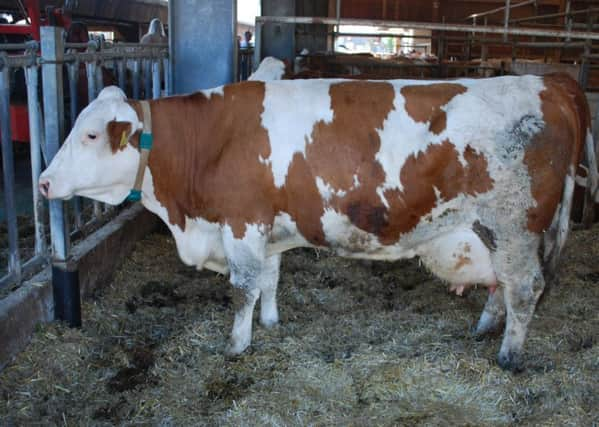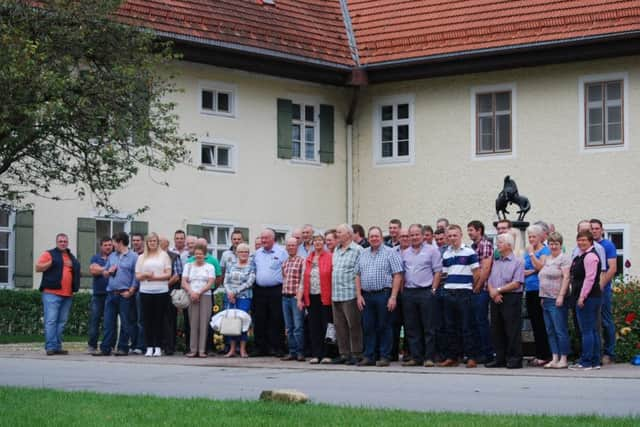German Fleckvieh herds impress


Many of those on the trip are currently milking half and three-quarter-bred Fleckvieh crosses which are performing well, but they were keen to ascertain whether to back cross, use a third breed, or keep on using Fleckvieh until a pure herd evolves. At the end of the trip everyone agreed that the pure-bred Fleckvieh was the optimum breeding goal.
The itinerary included visits to five pedigree Fleckvieh herds producing between 8,000 and 11,000 litres from trouble-free cows, with the added extra of approximately 10 Euro cents per litre from the beef calf and cull cow. This financial benefit doesn’t take into account the breed’s ease of management which results in reduced veterinary and semen costs, and a surplus of breeding heifers for sale.
Advertisement
Hide AdAdvertisement
Hide AdEveryone agreed that the Germans lead the way when it comes to premium brand cars. The same can be said with the current world-wide surge in the popularity of the Fleckvieh breed – numerically the number two dairy breed, closely following the Holstein.


The first stop on the German tour was the Bayern Genetik AI Station – the world’s largest Fleckvieh stud. Delegates were welcomed by the company’s export manager Christoph Gschoderer, who gave a comprehensive presentation about Bayern Genetik and its breeding goals.
The group had an opportunity to see a parade of top Fleckvieh bulls, semen from which is currently marketed in GB and Ireland. For Bio Security reasons the bulls were inspected from behind a glass partition.
The company’s young bull procurement manager Hans Holzer, introduced the bulls and detailed the pedigree and attributes of each individual sire. One noteable absentee was the famous Walbrand, the most popular AI bull in Germany 2012 and 2013. The group saw him later in the week at the Agricultural Fair in Munich.
Advertisement
Hide AdAdvertisement
Hide AdNext stop was the Bavarian Government’s research station LFL, where the delegates were given a tour of the facilities which feature a pedigree Fleckvieh herd milked robotically.


The herd is currently undergoing a feed trial studying the effects of reduced concentrate usage, designed to evaluate the most economic regime to produce milk more efficiently in times of poor milk prices.
The delegates were amazed at the size, muscularity and dairyness of the herd. The cows were housed continually, and the in-calf heifers were in the adjoining pasture. The baby calves in the calf rearing unit were very impressive.
There was a bull beef fattening unit across the yard, where feed conversion and daily liveweight gain trials are ongoing on two groups of Brown Swiss and Fleckvieh pure bred bulls destined for slaughter at 19 months.
Advertisement
Hide AdAdvertisement
Hide AdAfter lunch the group made a 45-minute journey to George Dold’s 60-cow herd. The herd boasts an average yield of 10,500 litres at 4.2% fat and 3.6% protein, with a calving interval of 382 days.
Bull calves were sold off the farm for fattening at five or six weeks of age, weighing approximately 90kgs, and fetching 450 Euro per head.
Mr Dold claimed that the price of the bull calf, and the cull cows, is equivalent to 10 Euro cents per litre of milk.
The farm was 900 metres above sea level. However, Mr Dold had 100ha 1,000 metres above sea level where his in-calf heifers and dry cows spent the summer months. With no road network up to these pastures, feed for the animals was air lifted by helicopter at the start of the season.
Advertisement
Hide AdAdvertisement
Hide AdDay two brought the delegates to Kraus Farm, home of 220 pedigree Fleckvieh cows boasting a herd average of 11,000 litres at 4.2% fat and 3.6% protein. The 200ha farm is divided into 120ha of grassland and 80ha of crops. All animal feed is produced on-farm, with the exception of minerals and the rape seed meal which is used instead of soya.
Maize harvesting commenced mid-September, and the total workforce on the farm included the farmer and his wife, their two sons, and a female student. A Bio Gas plant was built in 2010, and the cows were milked by a robot featuring a robotic arm which serviced four stalls in a line.
Next stop was a visit to Joseph Aidelsburger’s 90-cow herd. Two famous Bayern Genetik sires, Roundup and Manitoba, were bred on this farm. The herd average is 10,500 litres at 4.1%fat and 3.6% protein, with a calving interval of 367 days.
There are three generation on this family farm, which comprises of 63 has divided into 20ha of grass, 25ha of maize and 18ha of crops. Current milk price is 22 Euro cent per litre, and this farm also has a Bio Gas plant.
Advertisement
Hide AdAdvertisement
Hide AdThe third stop was a 55-cow herd owned by Michael Kappelman, who bred the recently proven Fleckvieh sire Riejka. This farm had a herd average of 8,000 litres at 4.1% fat and 3.5% protein, with calving interval of between 360 and 370 days. Current milk price is 23.5 Euro cent per litre.
This 38ha farm has 23ha of grass and 15ha of maize. The cows were fed a TMR ration of 70% grass silage and 14% maize silage, with the addition of rape seed meal, wheat and brewers grains. No genetically modified seed is used on this farm.
The third day started off with a visit to the famous Schwaiganger Horse Stud, where the group saw various different breeds, and were given a detailed presentation about the history of the stud.
The main focus here is in breeding world-class show jumping horses, and training top-class jockeys to ride them.
Advertisement
Hide AdAdvertisement
Hide AdThe group had a complete tour of facilities, including the indoor arena, semen collection area and the forge.
After lunch the group visited the 40-cow herd owned by Alois Kramer. Established 18 years ago, this farm is producing an average yield of 9,500 litres at 4.3% fat and 3.5% protein, with a calving interval of between 358 and 368 days.
This farm is 900 metres above sea level and consists of 65ha of grass and 80ha of forest. The cows are fed a diet of 50% hay, 45% silage and 5% maize (bought in), with the aim of achieving an intake of 22kgs of dry matter.
This farm is not organic, but adheres to supermarket specifications for feed and fertiliser use, and is presently receiving 35 Euro cents per litre.
Advertisement
Hide AdAdvertisement
Hide AdFrom the end of May to September each year in-calf heifers and dry cows are grazed on common ground shared with eight other farms. It is 17Km away and 1,800 metres up in the Alps. The group saw a batch of 38 cows and heifers, all with neck bells, which had come down from the mountain the previous day.
One of the highlights of the trip was a visit to the Agricultural Fair in Munich. This is a ten-day event and is held every four years in conjunction with the Munich Beer Festival.
The livestock show was indoors, and the popularity of the Fleckvieh breed in Bavaria was evident with over 70 entries catalogued, when compared to six Holsteins and a few Brown Swiss.
The Fleckvieh champion of the show was an Engadin daughter. Engadin was one of the first Fleckvieh bulls marketed by Bayern Genetik in the UK.
He has left a favourable impression with hundreds of elegant and high producing daughters performing in Northern Ireland and UK herds.